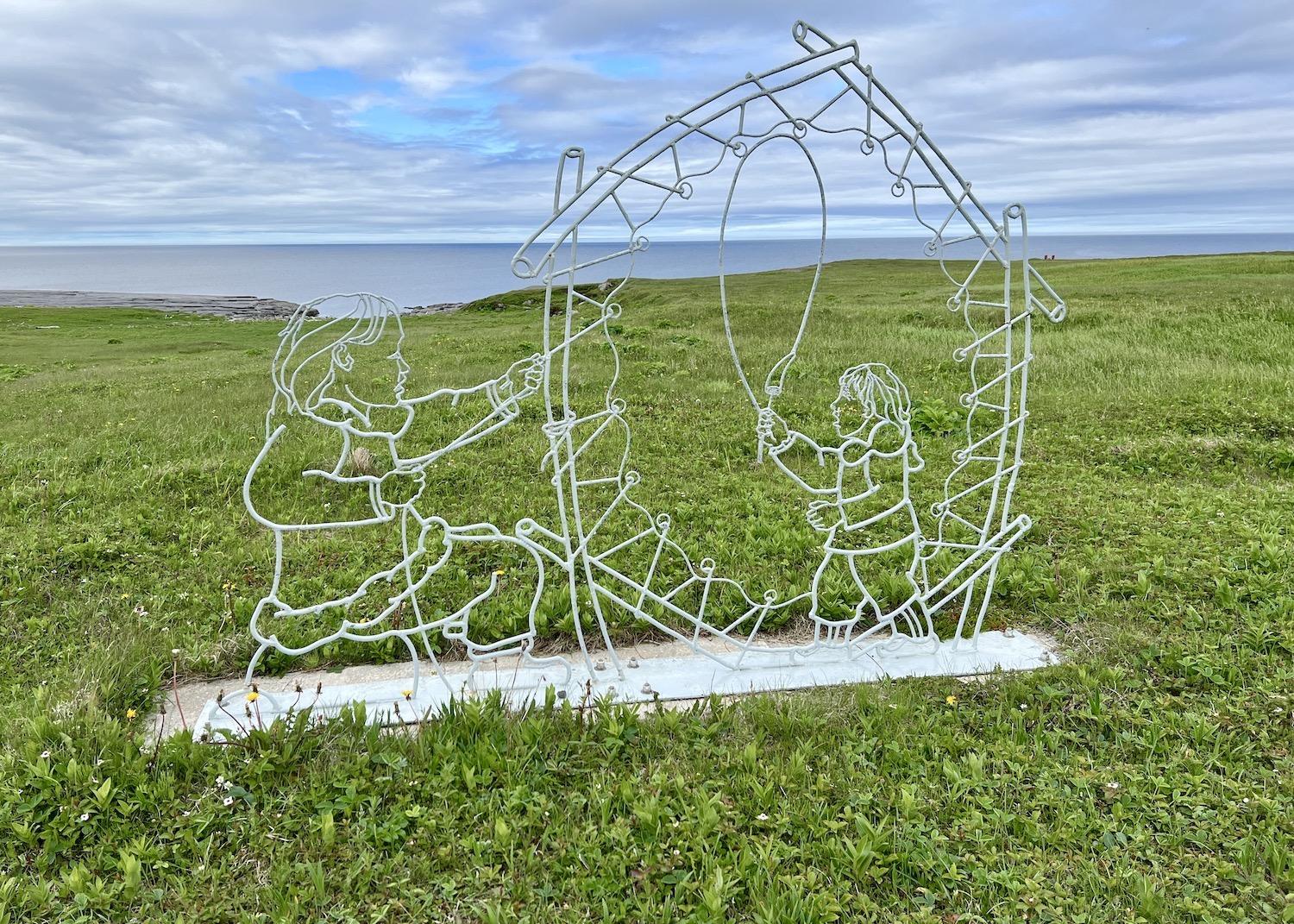
Near Point Riche Lighthouse at Port au Choix National Historic Site, this "Mother and Son" sculpture by Jim Maunder and Michael Massie commemorates Indigenous settlement in the area and depicts sealskin preparation/Jennifer Bain
Along the windswept northwestern coast of Newfoundland where four ancient cultures once lived off the sea’s bounty, a lone caribou grazed, indifferent to my family’s delight and seemingly safe in the knowledge that it can no longer be hunted in this protected landscape. We held up a card from Port au Choix National Historic Site that warned us to stay at least three bus lengths away from this gorgeous species at risk. There was a thumb-size rectangle cut out of the cardboard.
“Hold the card at arm’s length and the animal should fit within the frame,” the instructions read. “If it doesn’t fit, you are too close. Move away.”
We were at a respectful distance that cool July day. The Woodland caribou, whose fur coat still had more white patches for winter camouflage than brown ones, wandered off along the limestone barrens in search of tasty lichens and flowering tundra plants. We also moved on down the road to find two pieces of outdoor art — a steel sculpture of a mother and son preparing a sealskin, and a steel and limestone interpretation of a Dorset Paleoeskimo house that was found nearby.
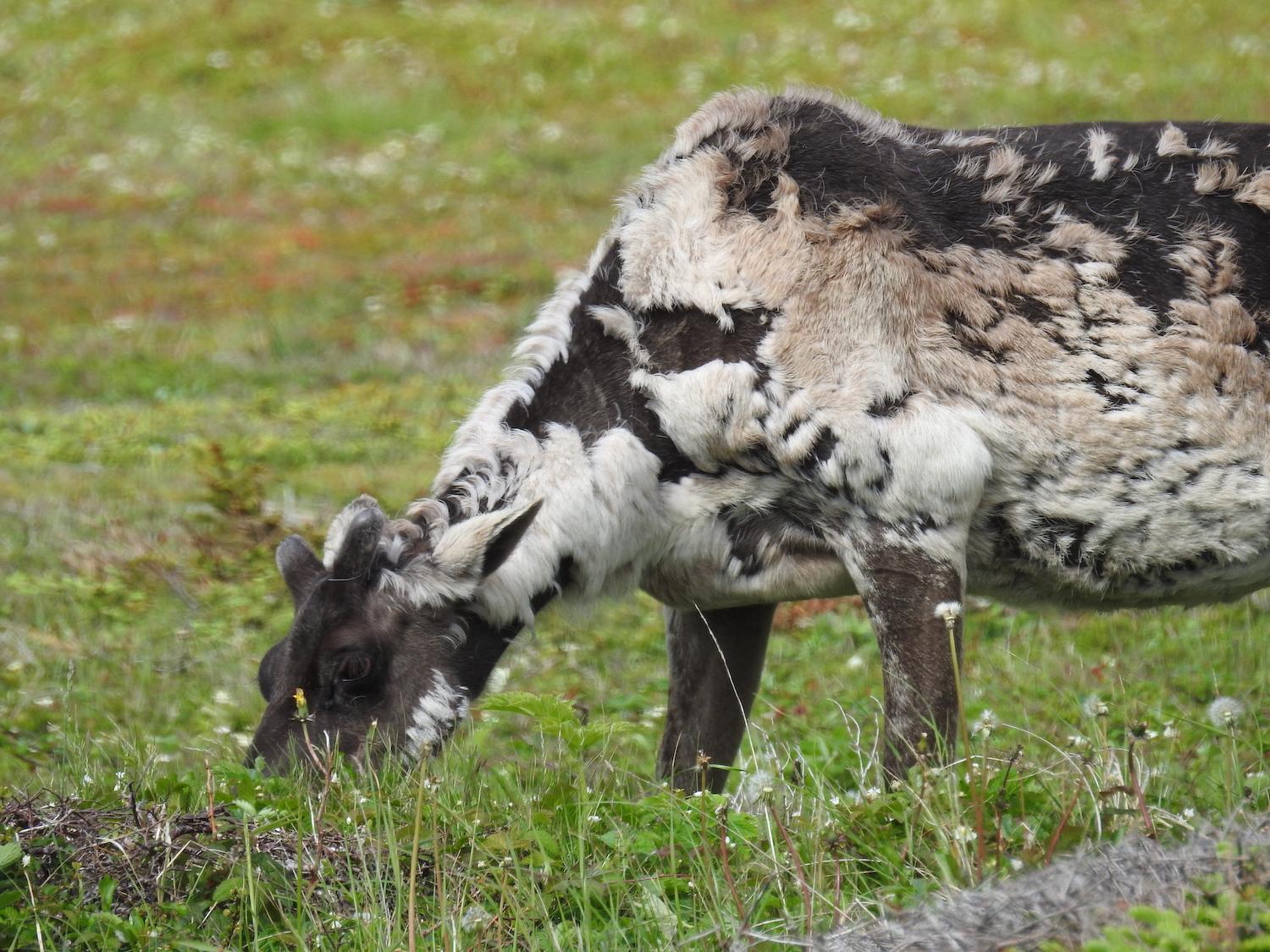
A Woodland caribou, its brown summer coat mixed with its white winter coat, forages in Port au Choix National Historic Site in western Newfoundland/Jennifer Bain
Beautiful and barren. Wild and windy. This tempestuous Atlantic shoreline was the seasonal home of the Maritime Archaic, Dorset, Groswater and recent Indigenous Peoples long before the Europeans showed up. A national historic site since 1970, Port au Choix is too often overlooked by people racing along the Viking Trail between Gros Morne National Park and L’Anse aux Meadows National Historic Site.
What a shame. We explored the limestone barrens looking for rare Arctic flowers, plants and fossils. We followed coastal trails past a lighthouse and pondered a time when harp seals were hunted for food, shelter, clothing and oil. We viewed burial grounds and the remains of ancient settlements. And we lingered in the visitor center by a life-size, replica Dorset dwelling and original artifacts like spearheads and bone needles.
“We’ve got 6,000 years of history,” interpreter Eileen Rumbolt told me. “We’ve got our limestone barrens, we’ve got our flowers, we’ve got our burial site and we’ve got our beautiful walking trails. You can spend easily a day or a day and a half here in Port au Choix if you want to come and experience the site.”
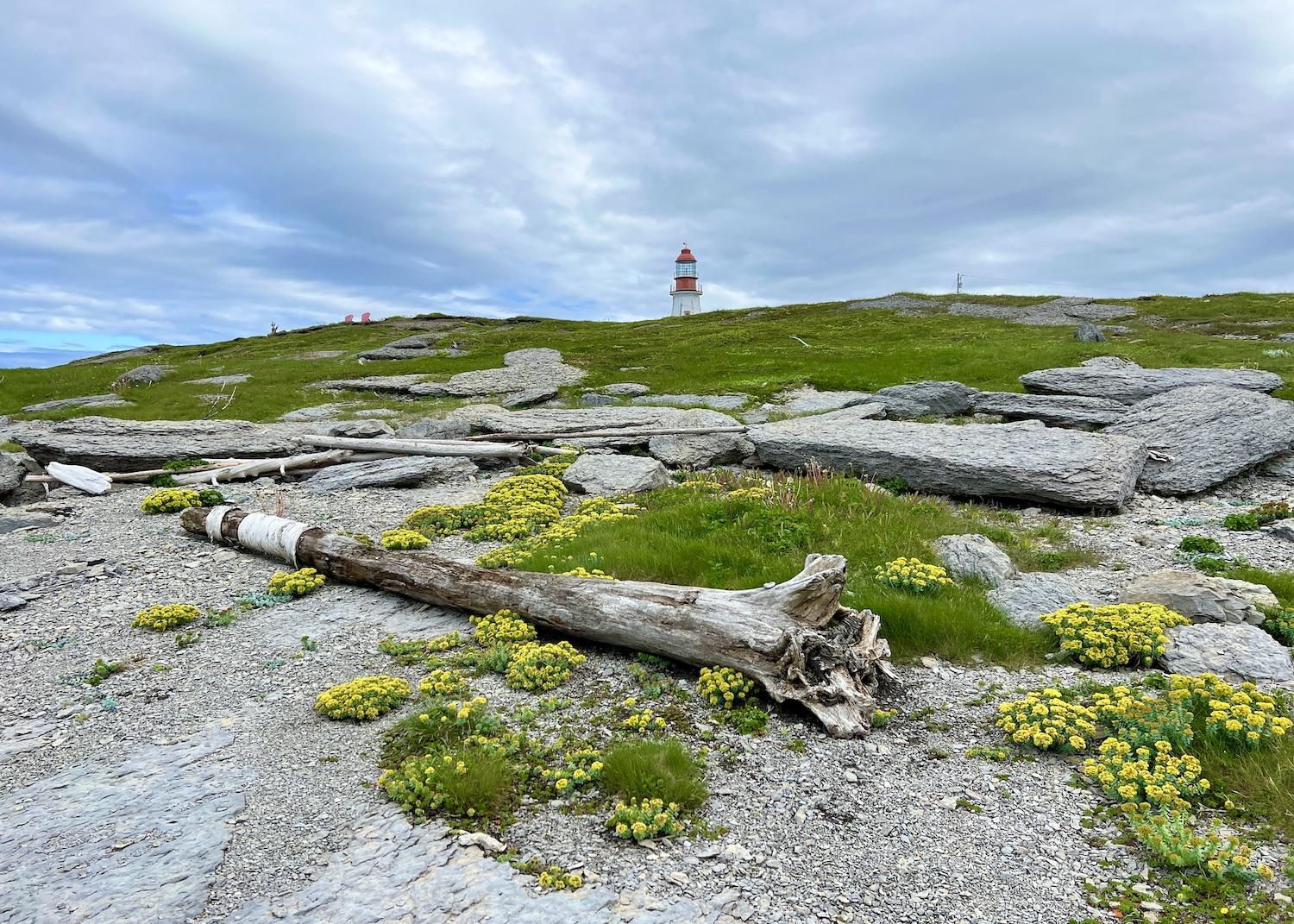
The Point Riche Lighthouse stands on flower-dotted limestone barrens in Port au Choix National Historic Site/Jennifer Bain
Port au Choix, a vibrant fishing community, is home to about 742 people and the studio where Ben Ploughman makes 3D wooden folk art to tell stories of rural outport life. During the late 1500s and the 1600s, the Basque fished this coast and named this and other communities as England and France waged a long battle for control of the island. The French Rooms Cultural Center details how, under the Treaty of Utrecht of 1713, French fishermen caught and dried fish here until 1904 but weren’t allowed to create permanent settlements. They did build communal outdoor ovens and now costumed interpreters bake in a replicated oven and serve heavenly warm buns with local jams and tea to summer visitors.
Newfoundland finally joined Canada in 1949. But it’s the pre-European history of this area's original hunters and gatherers that deserves (and gets) attention at the national historic site each year between June and early October.
For nearly 6,000 years, people have been drawn to this small peninsula for its rich marine resources, wild game, abundant berries and forests. The remains of four distinct cultures have been preserved because of limestone bedrock formed by the compaction of coral plant and animal remains on the bottom of what was once an ocean. Artifacts have survived thanks to the unusual alkaline soil.
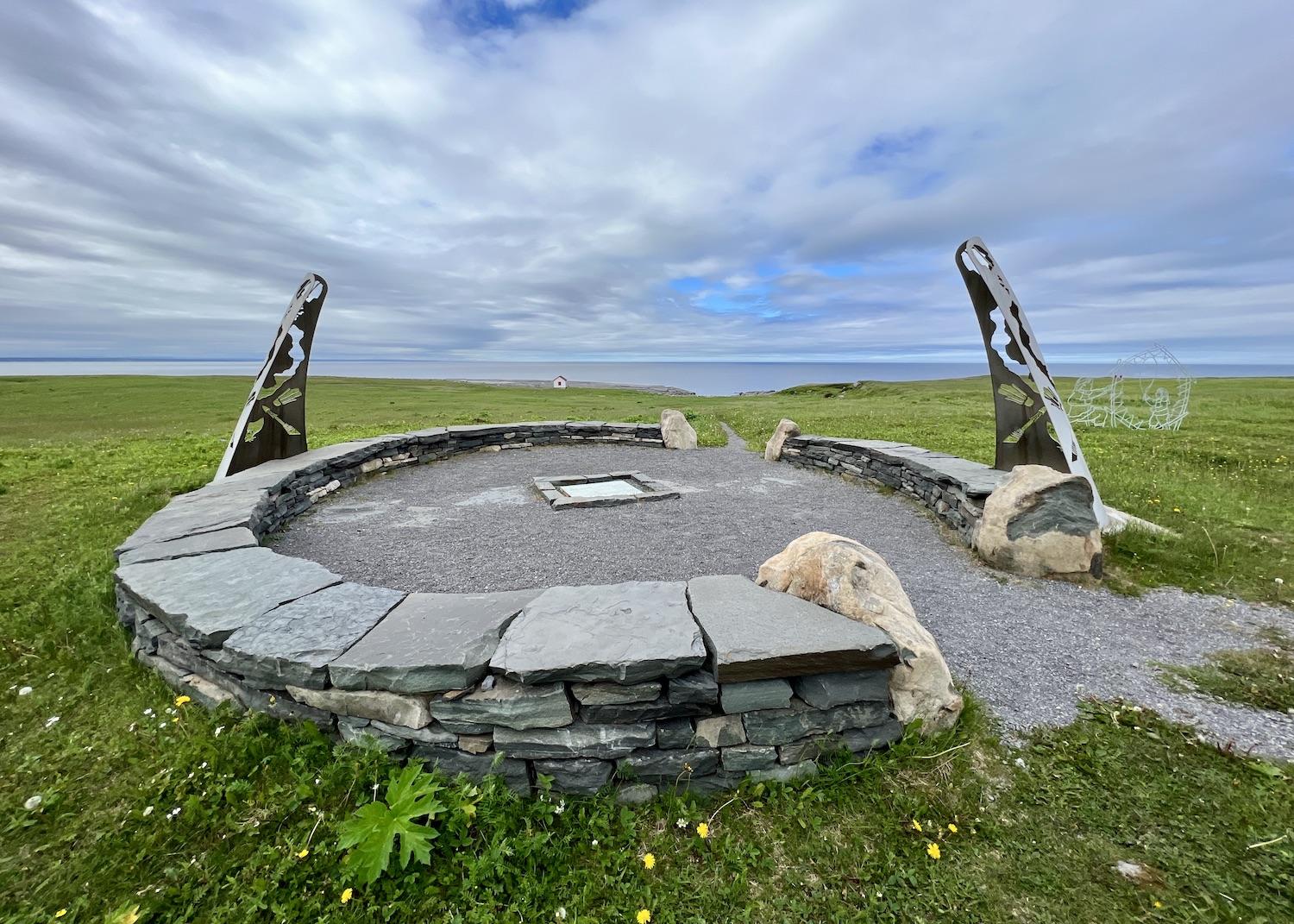
"Dorset Doorway" by Jim Maunder and Michael Massie is an artistic interpretation of an ancient Dorset house uncovered at nearby Phillip's Garden/Jennifer Bain
I read how the Maritime Archaic were the earliest known people to frequent the area 7,500 to 3,500 years ago. They lived off the sea and were hunters and gatherers (not farmers). Three of their cemeteries have been uncovered here, as well as bone, stone, antler and ivory tools plus weapons and ornaments.
After they disappeared, the Groswater Paleoeskimos arrived from the Arctic — possibly as the climate cooled — to hunt seals on the ice close to shore every spring. Their unique bone, ivory and antler harpoon heads have only been found here. They set up seasonal camps at Phillip’s Garden, near where seal hunters still take off by boat.
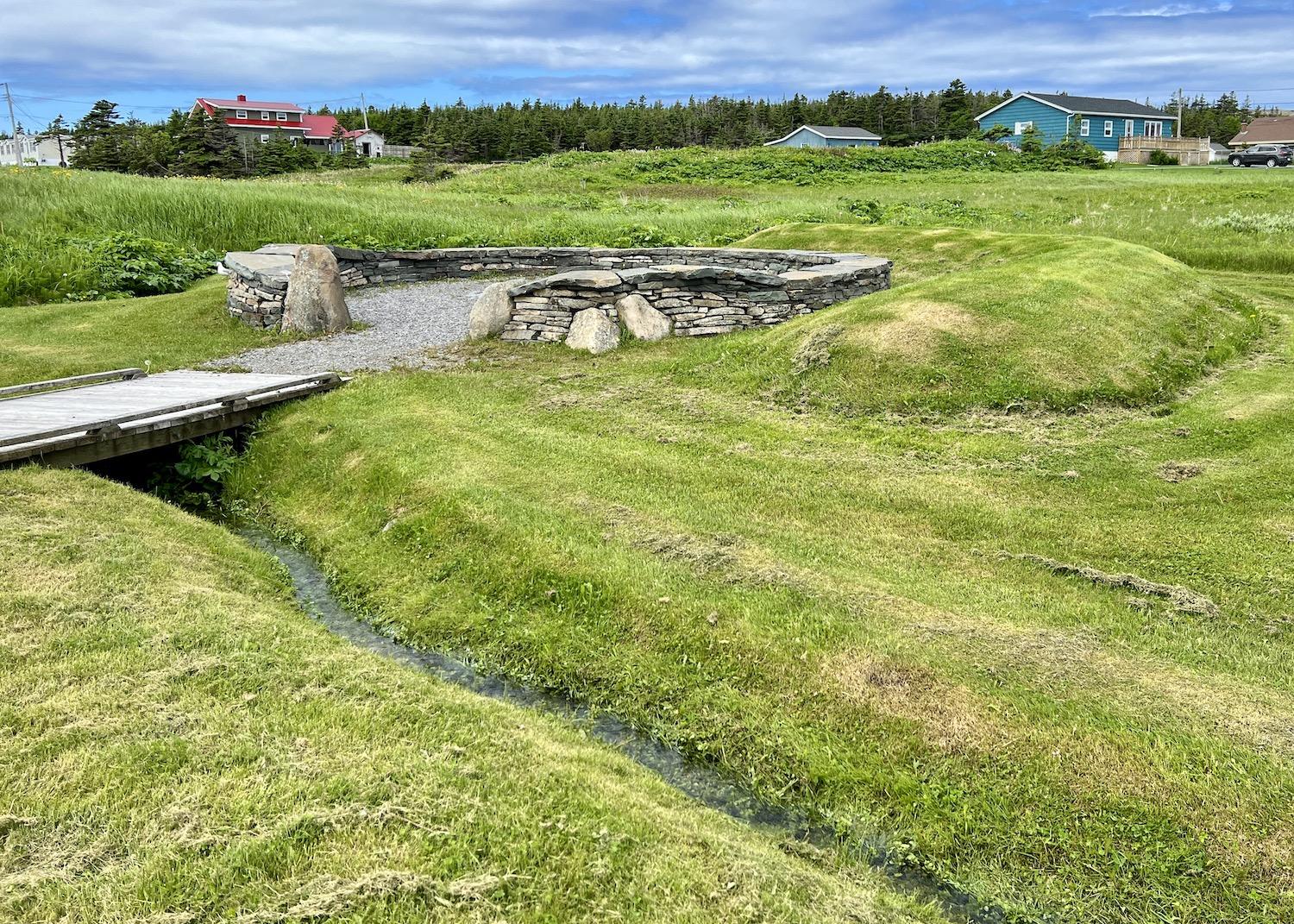
In the community of Port au Choix, an ancient Maritime Archaic burial site is protected by Parks Canada and now called the "Gathering Circle"/Jennifer Bain
When the Groswater people disappeared, they were replaced by the Dorset, another Arctic Paleoeskimo culture that created what appears to be a more permanent settlement from 2,000 to 1,300 years ago at Phillip’s Garden. It’s one of Canada's richest Dorset sites with at least 50 house depressions and thousands of artifacts. Dorset hunters walked out on the ice to catch their prey, and so much seal oil has remained in the ground that archaeologists say that the soil still feels greasy.
Finally I read how the Beothuk and other more recent Indigenous Peoples lived in the area from 2,000 to 300 years ago, drawing on resources from both the sea and land, and camping in sheltered coves around the present-day town instead of the exposed coast of Phillip's Garden.
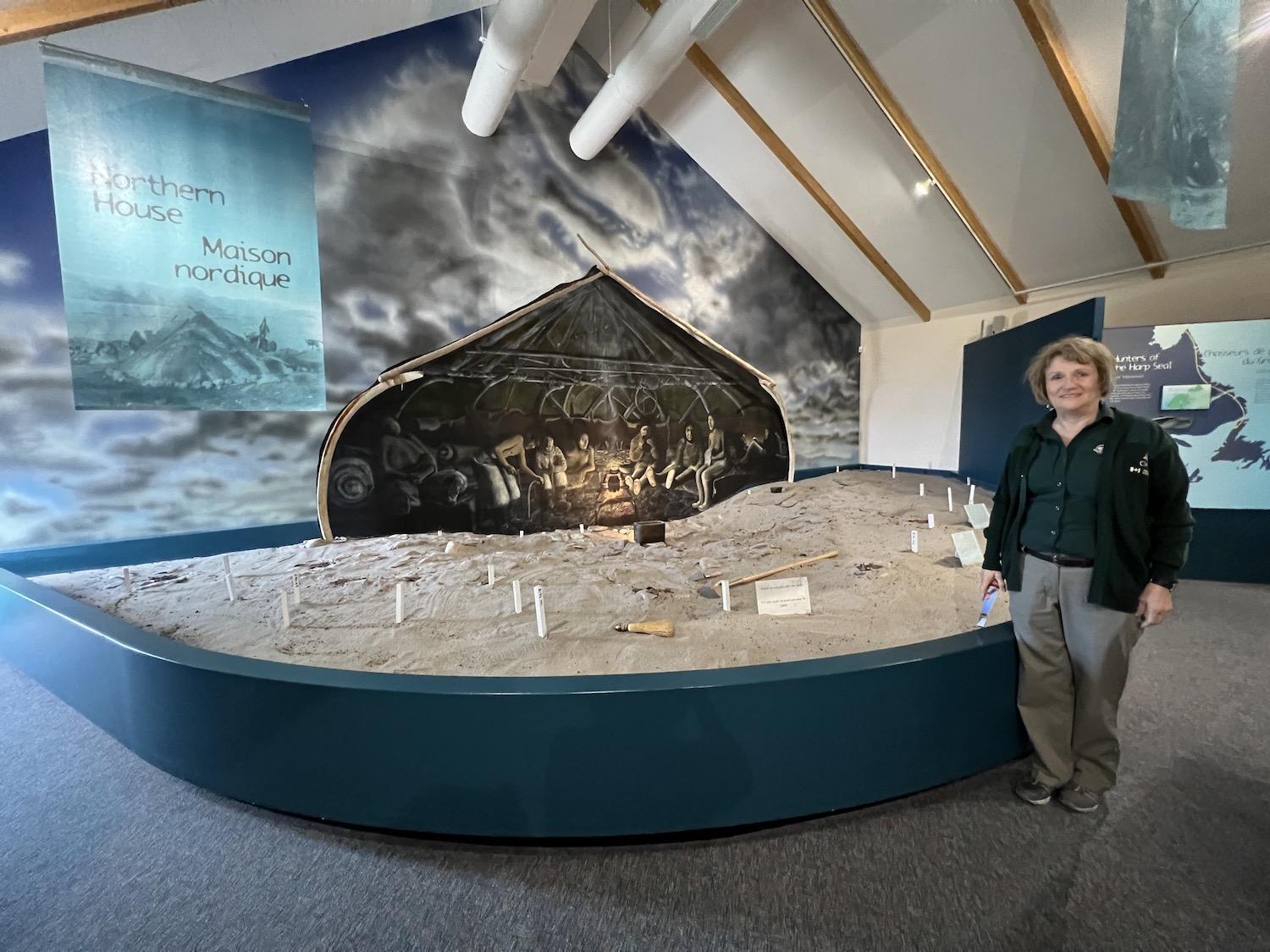
Inside the visitor center at Port au Choix National Historic Site, interpreter Audrey Rumbolt shows a reconstructed Dorset house/Jennifer Bain
“These people had the spiritual belief that if you killed an animal, you respected the spirit of that animal, and you would take a bone and carve something with the belief that you were giving respect to that animal,” said Rumbolt as she pointed out cases full of tools, amulets and other artifacts. “And the next time you went hunting that spirit would return and you would have another successful hunt.”
For thousands of years, seals from this bountiful coast have provided people with the necessities of life. They were used not only for meat and fat, but the sealskins were processed for use as clothes, boots and other items needed to survive in a harsh climate. Parks Canada, I learn, offers groups a “Seal for all Seasons” program that lets people use ancient tools, learn how to prepare sealskins and discover the ways past and present cultures have used seals to sustain their livelihoods.
As Rumbolt noted, the ancient people were hunters and gathers, but modern-day Newfoundlanders are "very much berry pickers. We hunt. We gather the wood — a lot of people heat their houses with wood. So it’s still an ongoing tradition. It’s changed over time, but we’re still doing very much the same thing.”
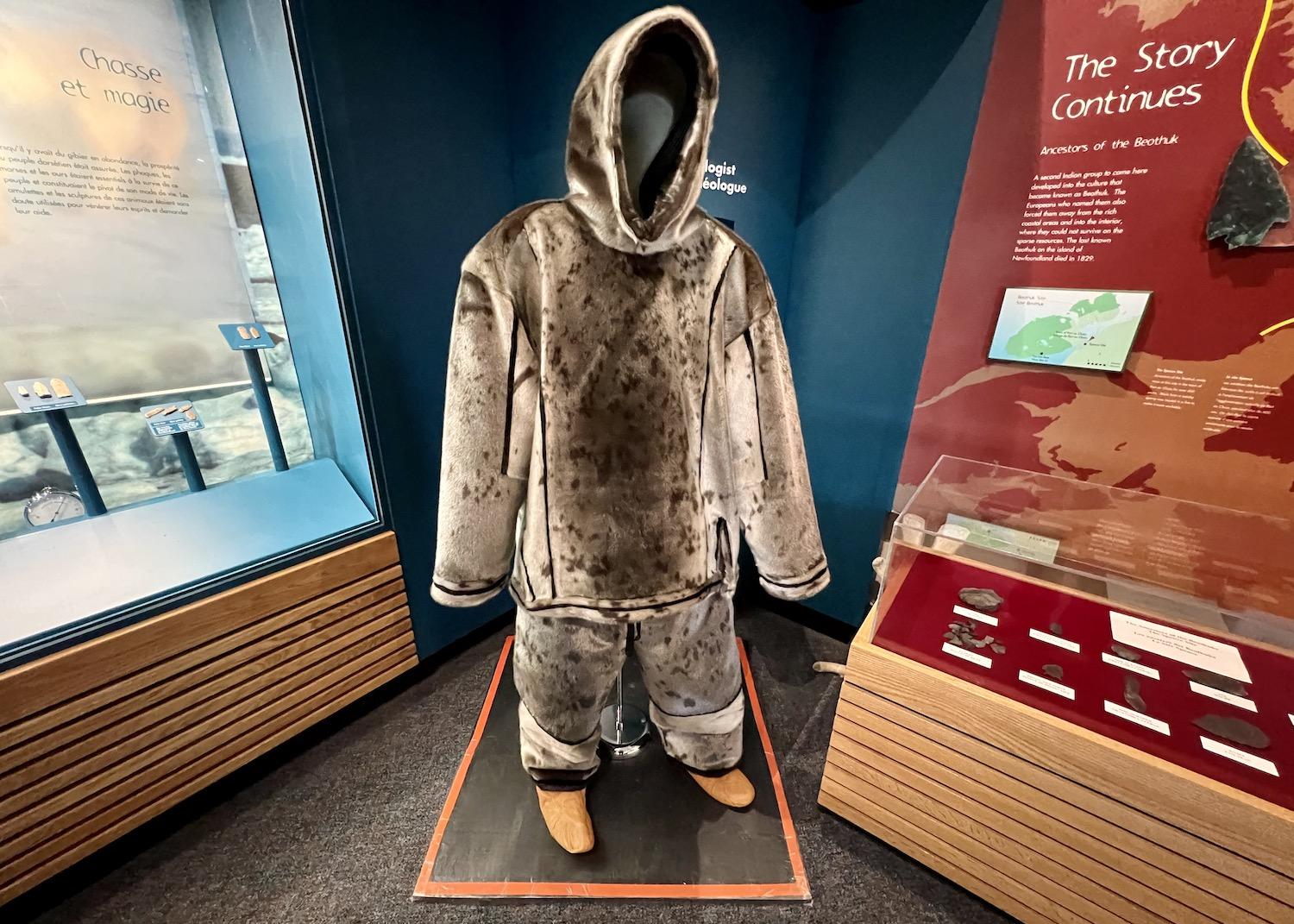
A sealskin outfit that's on display at the Port au Choix National Historic Site visitor center shows how marine mammals were essential for survival/Jennifer Bain
Six thousand years of history is tough to absorb in one go. I remember being struck as much as by what I didn't see as by what I did see.
One shuttered exhibit noted that the Maritime Archaic sacred burial ground was excavated by archaeologists during the late 1960s. "Study of the burial ground, including the burial objects inside these cases, has taught us much about these ancient people and the way that they lived and buried their dead," a sign explained. "Out of respect for the wishes of the Indigenous peoples of Newfoundland and Labrador and in the spirit of Reconciliation we have now concealed the objects from public view." The historic site is no longer allowed to show its short film to visitors and it awaits a new, more culturally sensitive, version.
Outside the visitor center — not far from where that lone caribou foraged so innocently — I cleared my head by walking in the footsteps of the ancient hunters and gatherers along three hiking trails.
What stood out was the "tuckamore," dense stands of fir and spruce that survive in exposed areas and are stunted and deformed by the ferocious winds. I wandered the limestone barrens and rugged coastline, finding the showy Yellow Lady's Slipper orchid but not the endangered Fernald’s Braya. Vibrant blue oysterplants and cheerful yellow roseroots — both beloved by foragers — were colorful consolation prizes as I scrambled over rocks to the Point Riche Lighthouse, a wooden octagonal beauty from 1892
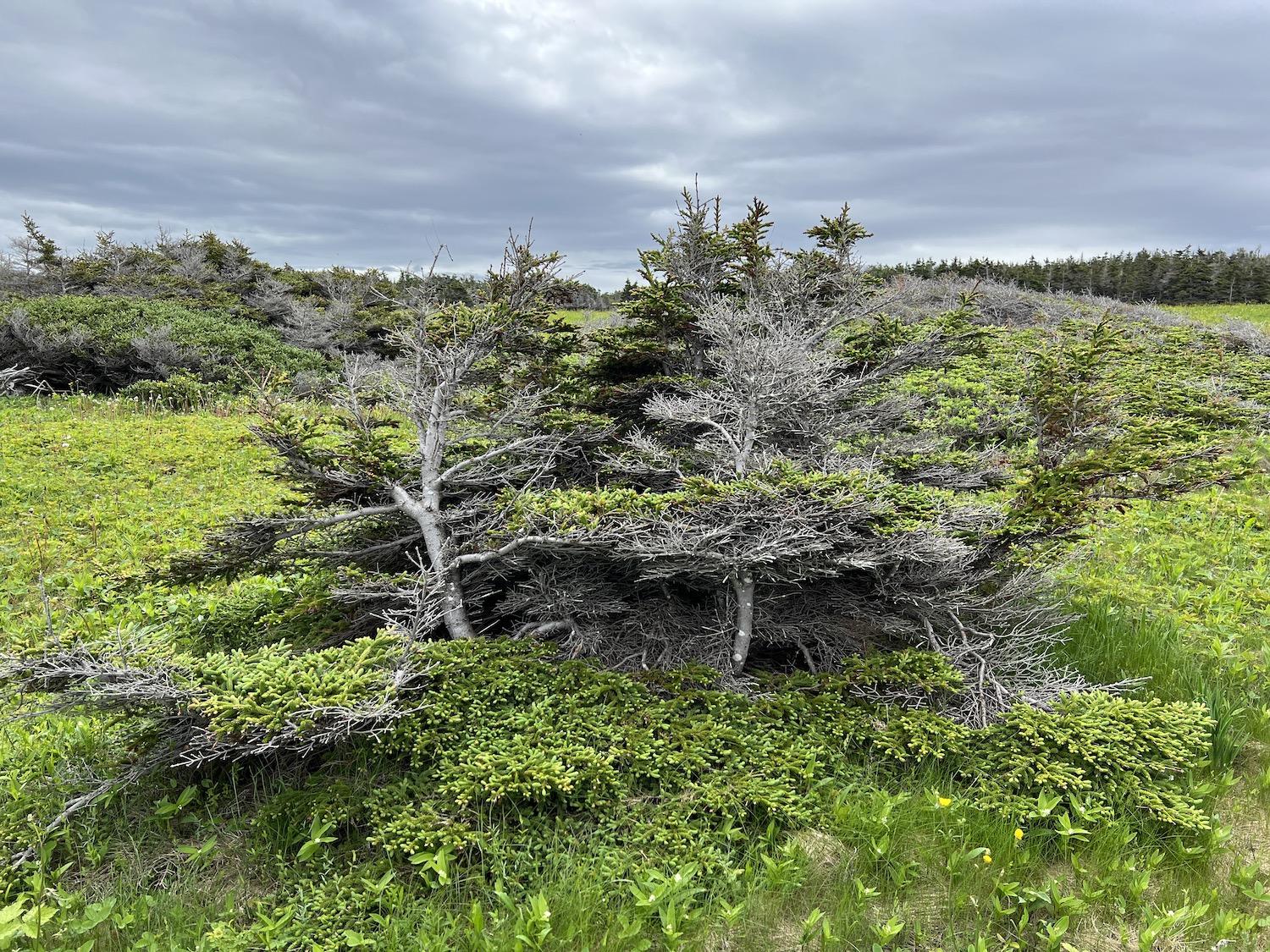
Newfoundlanders call these exposed and stunted coastal tree, deformed by fierce winds, "tuckamore"/Jennifer Bain
Facing the ocean at Phillip's Cove, I came across two more steel sculptures celebrating the area's rich Indigenous heritage. The first depicted two hunters pulling a seal, presumably over the ice, on a long rope. The second was a kayaker firmly gripping a paddle in one hand and a harpoon in the other.
Our visit to Port au Choix ended in town, across from the fish plant, at a small and sacred piece of land protected by Parks Canada. Now called the Gathering Circle, it's where the Maritime Archaic once buried their dead in elaborately furnished graves with limestone markers. Just outside a knee-high limestone wall, in the shadow of modern-day homes, lay a sombre grassy mound.
"Enjoy your time here and remember the special meaning this place once had," an interpretive sign said. "Please visit with care and respect."
While You're In The Area:
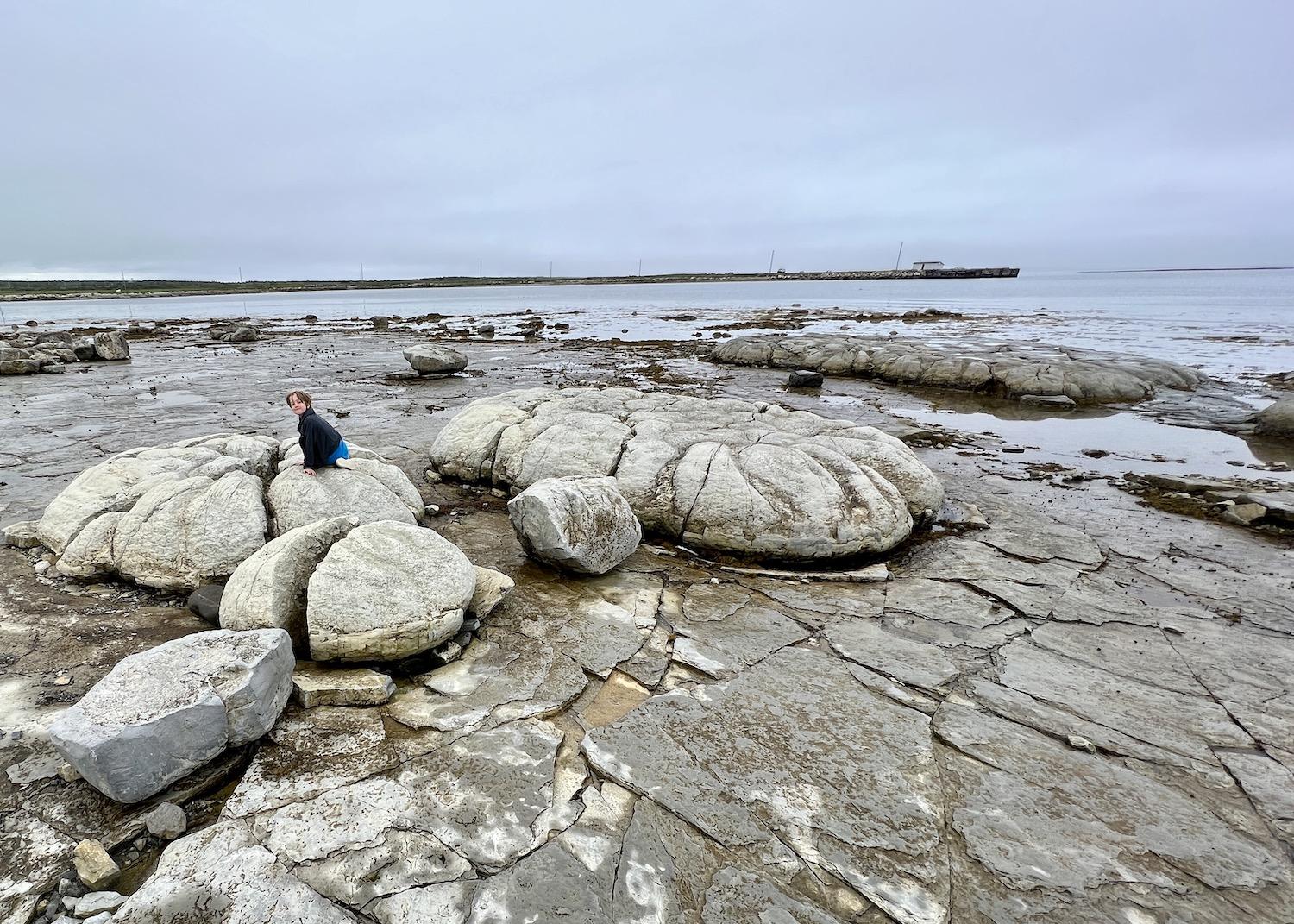
Flowers Cove is one of two places in the world to see 650-million-year-old fossil structures called thrombolites/Jennifer Bain
Leaving Port au Choix and driving north to L’Anse Aux Meadows, stop in Flowers Cove and take a short walking trail to see the thrombolites, critically endangered microbial structures that resemble the earliest forms of life on Earth from 3.5 billion to 650 million years ago. These bun-shaped mounds along the coast weather out of flat-lying dolostone. “They were the growth form of millions of tiny algae and bacteria,” according to an interpretive sign. “These structures are not exactly fossils but they are evidence for biological activity.” They also grow in Hamelin Pool in Australia's Shark Bay World Heritage Area, where they are called stromatolites. From Flowers Cove, it's another 10 minutes to Great Northern Peninsula (GNP) Craft Producers in Shoal Cove East to learn about sealing and preparing sealskin.
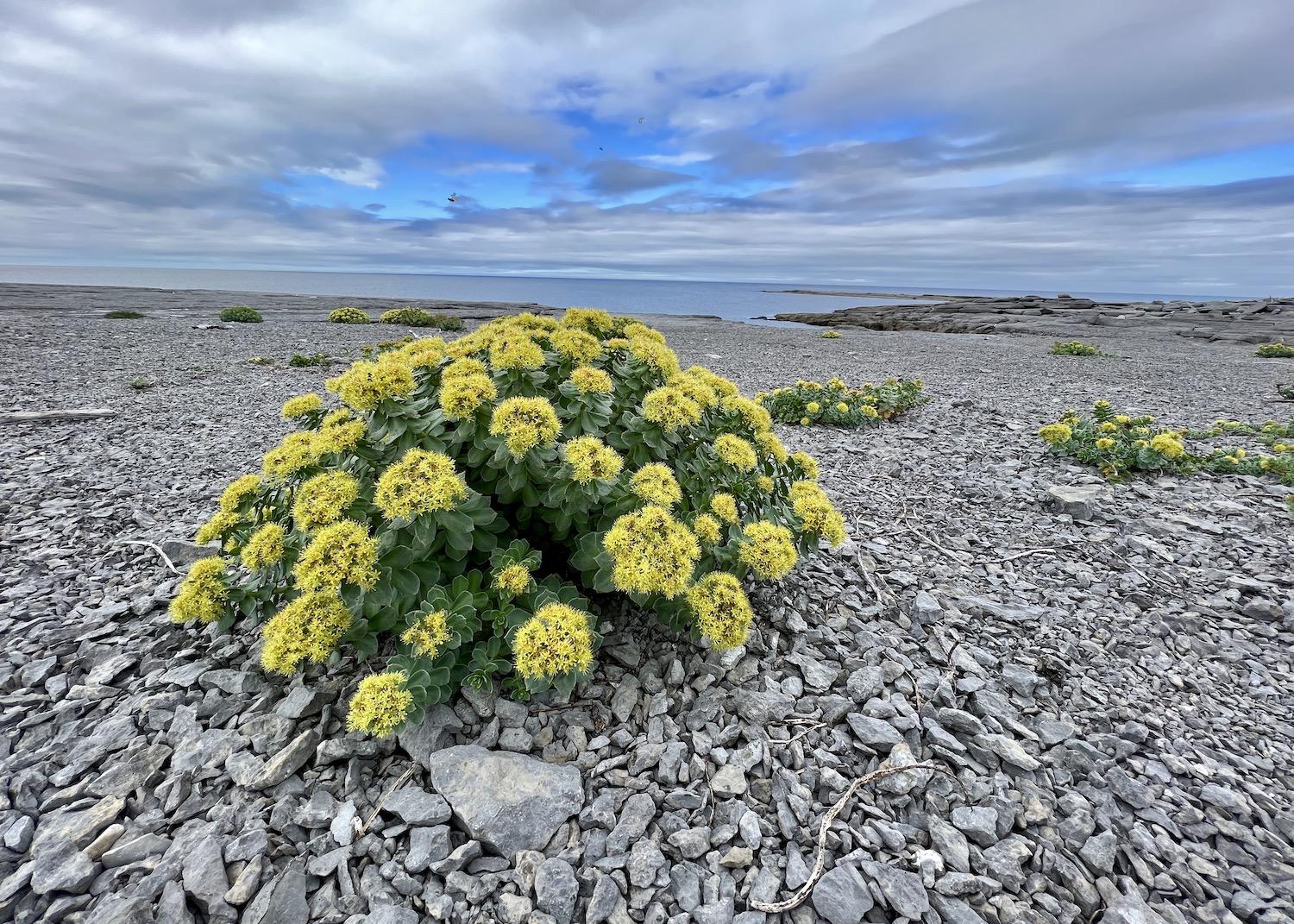
Roseroot flourishes by the ocean along the limestone barrens of Port au Choix National Historic Site/Jennifer Bain


